The Big Read: To tackle rising fatal traffic accidents and worsening road culture, we need to first understand the problem
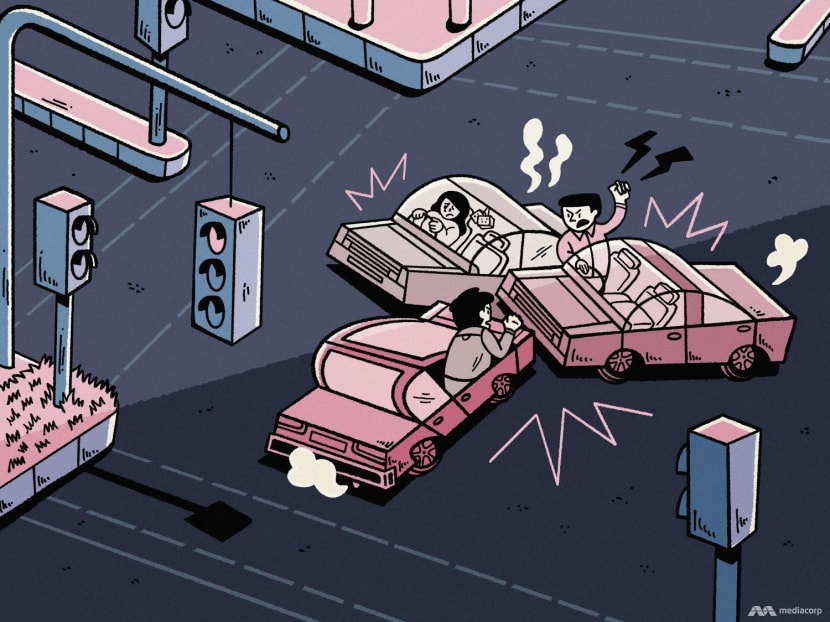
Experts and motorists TODAY spoke to believe a mix of stricter penalties, utilisation of speed-limiting technology in vehicles and continued education is the right way forward for safer roads. (Image: TODAY/Nurjannah Suhaimi)

This audio is generated by an AI tool.
This near-miss, alongside his increasing observations of drivers who hog lanes, display road rage and blatantly flout the rules, has led Mr Khoo, 29, to believe that the behaviour of motorists on the road has regressed - "more so than ever" since the easing of COVID-19 restrictions.
In TODAY’s conversations with seven motorists who have driven for at least five years, the sentiment is near-unanimous: Drivers' behaviours have been getting worse.
In recent months, Singapore has been gripped by several high-profile traffic accidents that have shone a spotlight on the country’s traffic safety measures, and by extension its road culture.
On Jan 23, a four-year-old was walking home from her preschool in River Valley when a car turned a bend and hit her. Barely a week later, a 12-year-old girl was on her way home from school in Taman Jurong when a van hit her.
Both children died in the accidents.
Last month, a multi-vehicle crash at the junction of Tampines Avenue 1 and Tampines Avenue 4 injured eight people and took the lives of 17-year-old student Afifah Munirah Muhammad Azril, and 57-year-old Norzihan Juwahib, who worked at a pest control company.
With traffic safety matters prevalent in Singaporeans’ collective consciousness of late, the issue was raised in Parliament this week, after several Members of Parliament (MPs) filed questions on what measures could be taken to improve road safety for users and whether the Ministry of Home Affairs would consider implementing mandatory speed limiters on all motor vehicles.
MPs also asked whether existing penalties under the Road Traffic Act 1961 should be reviewed.
In response to these questions on Tuesday (May 7), Minister of State for Home Affairs Muhammad Faishal Ibrahim said that the penalties under the Road Traffic Act - which had been raised significantly in July 2019 - "are already quite stiff" and adequate to deter dangerous driving.
The Road Traffic Act was amended almost five years ago to increase the maximum penalties for irresponsible driving offences like death or grievous hurt caused by dangerous driving, and for traffic offences committed while under the influence of drugs or alcohol.
Associate Professor Faishal said that Singapore’s roads "have become safer" too, as the number of accidents resulting in injuries or fatalities fell by about 10 per cent from 7,822 in 2019 to 7,075 in 2023.
Indeed, according to data gleaned from the Annual Road Traffic Situation reports published by the Singapore Police Force, there was a consistent decrease in the number of traffic accidents resulting in fatalities in Singapore from 2011 to 2019.
The 117 accidents reported in 2019 represented a 39.1 per cent decrease from the 192 reported eight years before in 2011.
This number dropped further to 80 in 2020 - when lockdown measures were implemented due to the COVID-19 pandemic.
According to transport engineering consultant Gopinath Menon, this fall in fatality-causing accidents is indicative of Singapore "moving in the right direction on road safety".
But since the start of the pandemic in 2020, the number of traffic accidents resulting in both fatalities and injuries has increased year-on-year.
From 2020 to 2023, the number of fatality-causing accidents jumped by 63 per cent from 80 to 131, while accidents resulting in injuries went up by 26.8 per cent from 5,476 to 6,944.
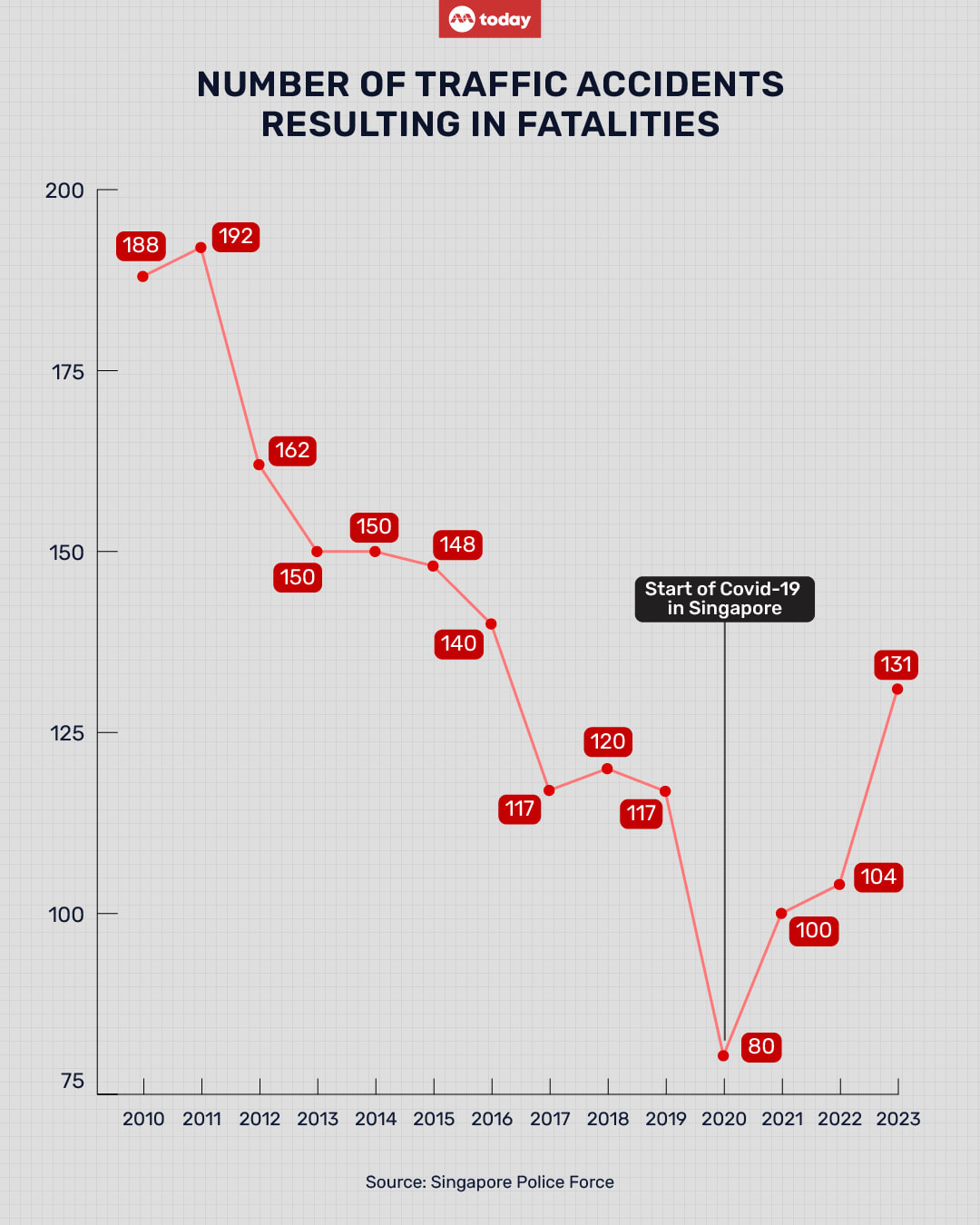
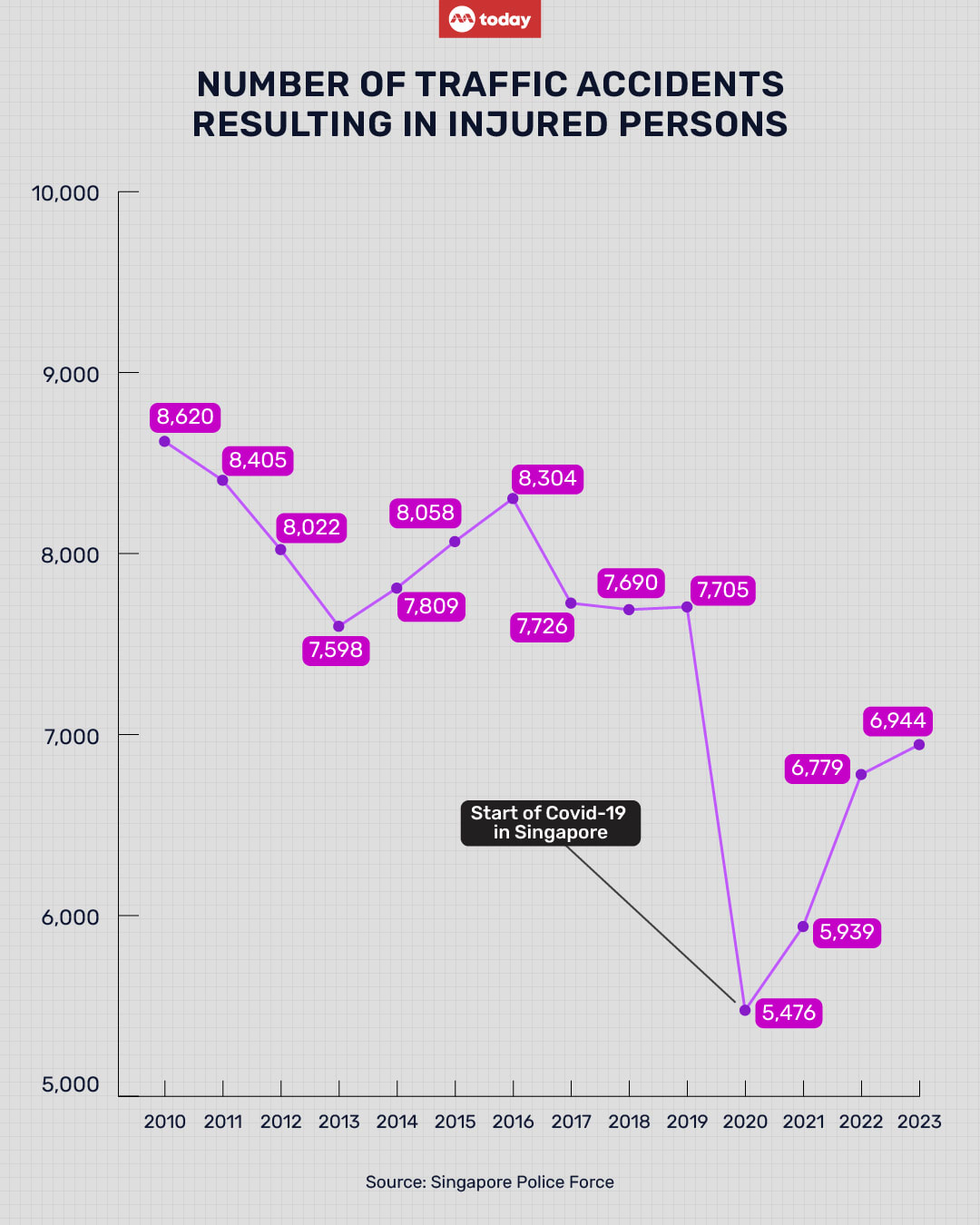
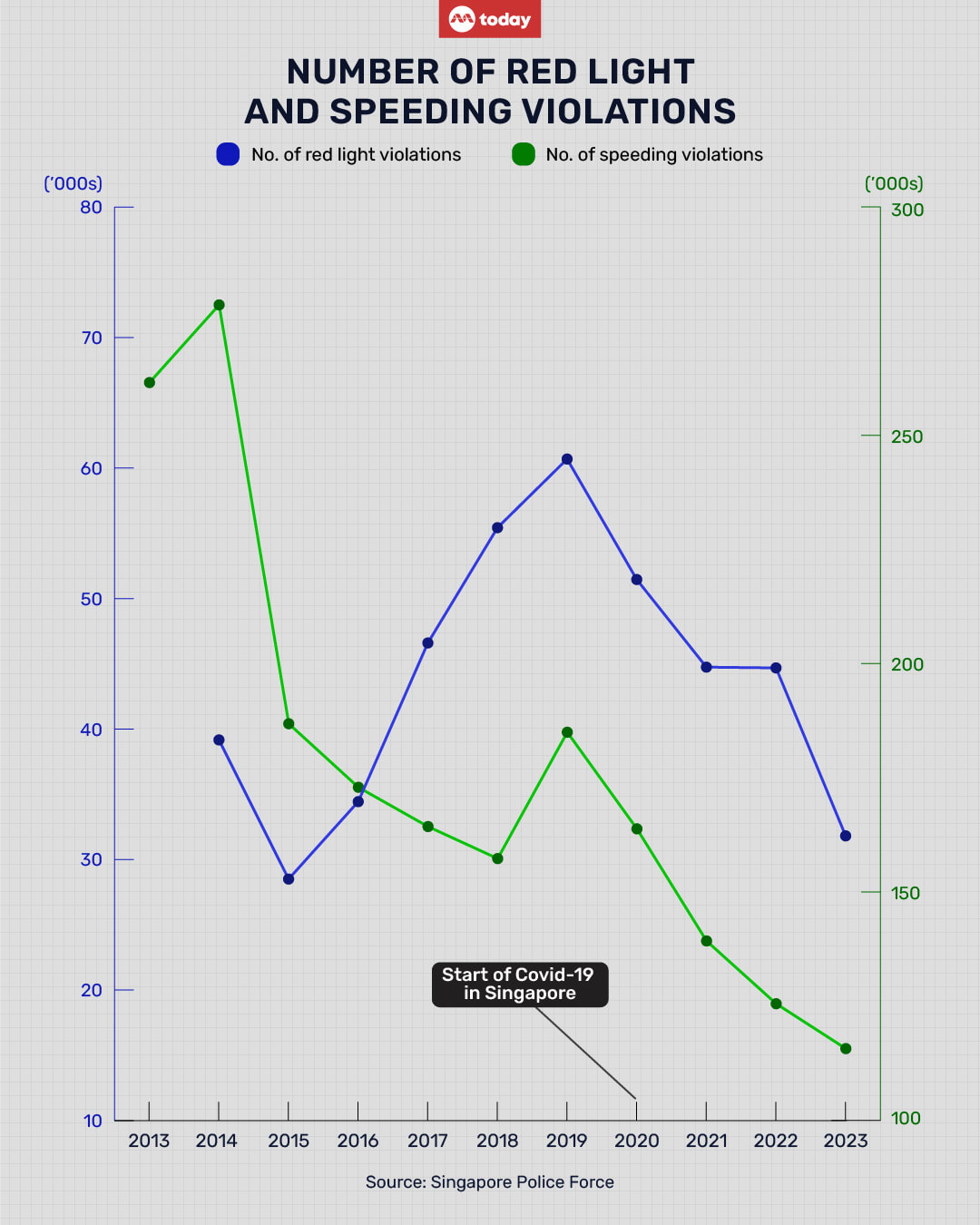
Overall, the road traffic fatality rate per 100,000 population increased from 1.46 in 2020 to 2.3 in 2023. This means that in 2023, around two out of every 100,000 people died from a road accident.
This was the highest since 2016, when the road traffic fatality rate was 2.51 per 100,000.
Additionally, a Singlife spokesperson told TODAY that the insurance company saw a relative increase in motor accident claims from 2021 to 2023, "often resulting from distracted driving induced by electronic devices, speeding, reckless driving and adverse weather conditions".
While it is not surprising that 2020’s numbers were lower, should the rise in fatality- and injury-causing accidents for the three consecutive years since be a cause for concern?
Law lecturer at Singapore University of Social Sciences (SUSS) Ben Chester Cheong thinks so, calling the increase a "worrying trend that should not be taken lightly".
“Road safety is a critical issue that affects everyone, and any regression in this area can have severe consequences for individuals, families, and society,” he said.
What could be behind Singapore’s apparent recent regression in road safety? TODAY looks at the potential causes and what can be done to improve the situation on the roads.
DID COVID-19 CHANGE MOTORIST BEHAVIOUR?
Being forced to stay at home more often at the onset of the pandemic may have caused a deterioration in safety standards on the roads, according to Mr Khoo, Mr Gopinath and several other motorists TODAY spoke to.
With fewer vehicles on the roads back in 2020, "some drivers might have developed a habit of speeding or driving less cautiously due to the perceived lack of traffic", said Mr Cheong of SUSS.
He added that the significant stress, anxiety, and mental health challenges that the pandemic caused for many people may have also led to more distracted and aggressive driving.
Indeed, there have been multiple studies in the region and beyond that have lent credence to Mr Cheong's perspective, indicating that COVID-19 has had a profound and lasting impact on road accidents and driver behaviour.
For instance, a Spanish study conducted in 2021 compared the driving styles of 30 participants before and after the pandemic.
The findings, published in the Institute of Electrical and Electronics Engineers Access Journal, showed that the drivers had adopted a more aggressive driving style since the pandemic, particularly those who had experienced anxiety because of COVID-19.
The Australian Road Safety Foundation’s annual research report in 2020 also showed that one in four drivers admitted to taking increased road risks since the implementation of COVID-19 lockdowns.
The foundation said this is likely driven by complacency and the fact that two thirds of Australians believe the roads are safer because of lower traffic volumes and congestion.
A separate study in the United States found that the aggression and inattention of drivers considerably increased following the emergence of COVID-19, resulting in a greater chance of serious collisions.
It measured aggressiveness using crash data, which captured instances of drivers speeding and drink-driving, while inattentiveness was measured by instances of motorists being unbelted, distracted or failing to signal.
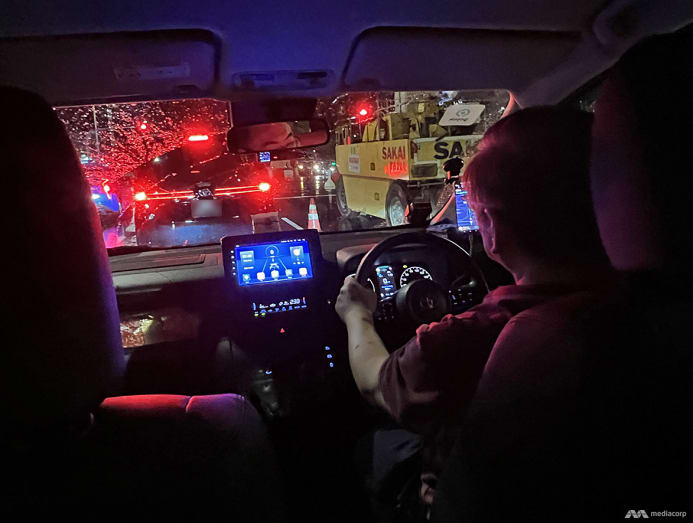
Closer to home, a Malaysian study published in the International Journal of Environmental Research and Public Health in 2022 found that young drivers in particular drove significantly faster and performed more aggressive steering actions during the COVID-19 lockdown than at any other time.
While there have not been studies examining the impact of the COVID-19 pandemic on motorists’ behaviours on roads in Singapore, Mr Gopinath said it is possible that these findings apply here too.
"Many drivers may have resorted to going at high speeds because they were able to do so.
"Impatience and general frustration because of the severe restrictions on the quality of life may have led to more red light running and reckless driving," he said.
In fact, from 2020 to 2022, the number of speeding-related accidents here did increase by 50 per cent (from 757 to 1,138), though that figure dropped sharply by 45 per cent to 624 cases in 2023.
But not all are convinced that COVID-19 had anything to do with road behaviours.
Data analyst Mohamed Aqmal, 27, believes that what he observes to be a "notable increase in reckless driving" simply boils down to "a continued manifestation" of road habits that have always been common in Singapore.
Transport economist Walter Theseira said that while there are correlations between COVID-19 and road safety, existing studies do not prove any hypotheses which point to a cause and effect between the two, and merely point out the differences in behaviour of selected motorists before and after the pandemic.
It is also interesting to note that despite fatalities and injuries from traffic accidents rising for three consecutive years, red light and speeding violations recorded have simultaneously and consistently fallen over the same period.
From 2020 to 2023, the number of red-light violations decreased by 38.2 per cent (51,459 to 31,815), with speeding violations dropping by 29.4 per cent (163,823 to 115,705).
However, statistics on such violations are more co-related with enforcement action than statistics on accidents.
One motorist, 28-year-old media creative Harris Iskandar, believes that this perception of increasingly unsafe roads may have been created inadvertently by the ubiquitous use of smart devices.
"Rather than it getting worse, (traffic) incidents are now easily made known to the masses due to the advent of social media," said Mr Iskandar, who has been driving for eight years.
CAR-SHARING AND RIDE-HAILING IMPACT ON ACCIDENT RATES
Pandemic aside, the past decade has seen several key changes in the way Singaporean motorists commute - specifically the emergence of ride-hailing applications like Uber and Grab in 2013, and the more recent popularity of car-sharing services.
As of end-June 2023, the private-hire car population stood at 76,686 - just 455 units shy of the peak in 2019 when there were 77,141 cars for self-drive rental and ride-hailing.
For car-sharing, GetGo told TODAY in January this year that it launched its service in February 2021 with 10,000 users, but now serves over 350,000 registered users.
Tribecar, founded in 2016, said it has seen an average of a 30 per cent year-on-year increase in registered users over the past three years, though it declined to reveal its total customer base.
Studies abroad have indicated that both ride-hailing and car-sharing have an impact on road safety figures, though they point in opposing directions.
In January 2023, an accident in Yishun involving a GetGo car and an SBS Transit bus resulted in the death of the car driver and injuries to seven bus passengers, which raised concerns about the safety of car-sharing services then.
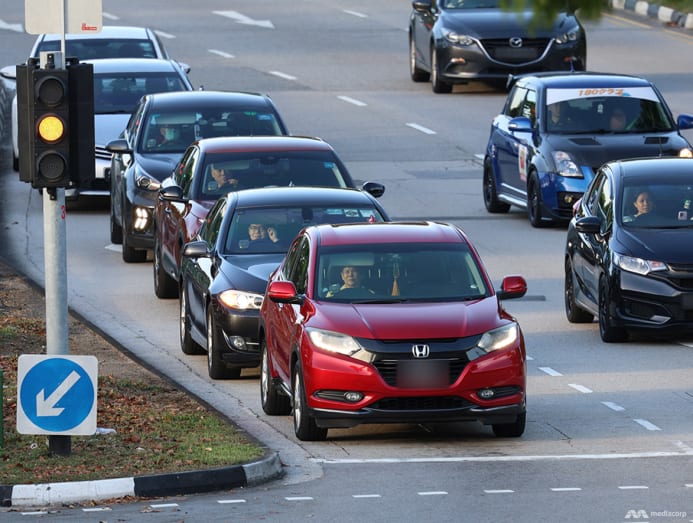
One 2019 study in South Korea found a causal relationship between the presence of a car-sharing service in an urban area and the number of car accidents there.
The more users a car-sharing service had in a market, the more accidents were recorded - particularly among experienced drivers, which the study defined as someone who has had a driver’s licence for at least three years.
According to the researchers, its results indicate that experienced drivers who used car-sharing services may show irresponsible attitudes or enhanced violence when driving a car, whereas inexperienced users’ attitude towards driving were stable regardless of whether they used shared cars.
But car-sharing’s impact on Singapore specifically is harder to quantify.
The Traffic Police does not track whether vehicles involved in accidents are car-sharing vehicles or not, said Minister for Home Affairs and Law K Shanmugam in a written response to a parliamentary question by MP for Aljunied Group Representation Constituency Gerald Giam in February 2023.
In response to TODAY’s queries, car-sharing company Tribecar said that it sees "less than a handful" road accident cases per 100,000 bookings and has had no reports of injuries or fatalities from its users.
Similarly, GetGo said that its accident rate as measured against usage remained consistent from 2022 to 2023 and decreased as of the first quarter of 2024.
Both companies did not provide figures.
As for ride-hailing, multiple studies overseas have shown that the presence of these options in a city tends to decrease fatal vehicular crashes.
A US nationwide study in 2018 found that once Uber has operated in a county for four or more years, fatal crashes decline by 17 to 40 per cent.
This is consistent with Singapore’s trend of declining fatality figures resulting from traffic accidents since ride-hailing apps entered the market in 2013.
In response to TODAY's queries, a Gojek spokesperson said 99.99 per cent of rides on the platform in 2023 were accident-free, although no figures were provided for preceding years.
Both Gojek and TADA said that their platforms also include safety features for its drivers, such as regular in-app reminders to rest, with the former also offering in-app learning modules on safe driving.
Additionally, a 2021 study in Spain showed that ride-hailing services were associated not only with a decrease in fatal and serious accidents in Madrid, but also a reduction of accidents related to alcohol.
While there has been no significant change in the number of drink-driving accidents recorded in Singapore over the past decade, the number of persons arrested for drink-driving did decrease year-on-year from 2013 to 2021 (from 3,019 to 1,453), before increasing slightly in 2022.
The police did not provide figures for how many people were arrested for drink-driving in 2023 in its latest Annual Road Traffic Situation report.
WHERE DO WE GO FROM HERE?
In that same report published in February this year, the Traffic Police said that it would, in view of the increase in number of accidents and fatalities:
● Increase enforcement efforts.
● Turn on the speed enforcement function in more red light cameras.
● Revise composition sums and demerit points for traffic offences.
● Intensify education and engagement efforts to encourage good road safety habits.
The speed enforcement function in red-light cameras had been progressively activated from April 1 in an effort to improve motorist behaviour on roads, and the police said last month that those cameras had detected more than 800 speeding violations in the first three weeks.
Experts and motorists TODAY spoke to were largely in favour of these actions, but also offered various suggestions on how to further improve road safety.

Some said stricter penalties should be in place to further discourage errant behaviour on the roads.
At present, for an offence of dangerous driving causing death, a first-time offender is liable for imprisonment of two to eight years.
Mr Cheong, the SUSS law lecturer, pointed out that the state of Queensland in Australia recently proposed legislation that would provide for imprisonment of up to 20 years for the same offence.
He said that introducing harsher penalties can lead to increased deterrence for reckless driving and raise more public awareness about the seriousness of road safety issues.
"In the past, it may not be practical or fair to impose severe penalties for traffic offences because of the difficulty in evidence collection and the difficulty in ascribing culpability (or blame) for an accident," Mr Cheong said.
"But now with in-car cameras, surveillance cameras, and camera footage from other vehicles, it is becoming very clear who caused the accident and who should be most culpable.
"Considering the spate of very serious and fatal road accidents in recent times, it is justifiable for more severe punishments, where traffic offences causing death or grievous bodily hurt are concerned," he added.
When it comes to fines for acts like speeding, Singapore’s current system may not be very effective in deterrence, said Associate Professor Theseira, the transport economist from SUSS.
At present, those who drive above the speed limit by 1kmh to 20 kmh will be slapped with a S$150 (US$ 111) fine and four demerit points. The penalty increases as the speed does too, with those caught going 60kmh above the speed limit potentially facing a S$10,000 fine or imprisonment of up to eight years or both.
Assoc Prof Theseira believes Singapore should follow the lead of several Scandinavian countries to implement fines that scale with the traffic offender’s ability to pay.
For instance, Finland’s speeding fines are calculated based on an offender’s daily disposable income - generally their daily salary divided by two.
In 2015, a Finnish businessman was handed a 54,000-euro fine for driving 22kmh over the 50kmh speed limit. Thirteen years before that, a former Nokia director was ordered to pay 116,000 euros for a similar offence.
"Such a system would make fines of similar meaning to high and low-income offenders and may provide more deterrence than the present system - where a meaningful fine to the average person is likely meaningless to the high income," said Assoc Prof Theseira.
Another way forward is encouraging the use of various advanced driver assistance systems in vehicles, such as collision warning systems, lane departure warnings and autonomous emergency braking features.
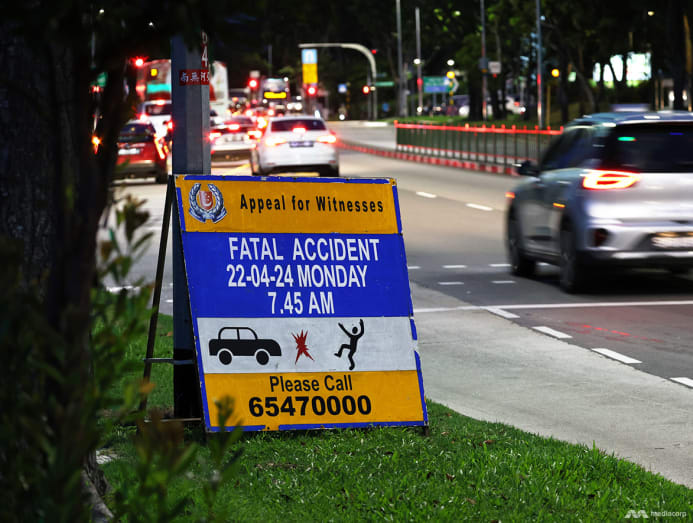
In a TODAY commentary earlier this week, SUSS senior lecturer Nicholas Netto suggested equipping all vehicles with Intelligent Speed Assistance technology, where traffic signs can automatically ensure vehicles comply with corresponding speed limits through an onboard communication system.
In-car cameras could also become standard in all vehicles, and footage of traffic violations synced via cloud to an artificial intelligence-powered analytics programme administered by the authorities to detect traffic violations, Mr Netto said.
Lastly, road safety education initiatives should be ramped up, TODAY’s interviewees said.
For one, Mr Cheong believes Singapore should implement mandatory "continuing road safety education" programmes for drivers before licences can be renewed.
Agreeing, Mr Benjamin Leow, 31, who is self-employed and has driven for almost 10 years, said the country’s focus should be on cultivating what he calls "road intelligence" - like knowing which lanes to stick to at various speeds and when to use one’s hazard lights, for instance.
"It’s unfortunate we have to stoop to such measures, but given we’re a country that advocates lifelong learning, this is a small way to decrease incidents on the road," he said.
In a similar suggestion, MP for Tanjong Pagar Group Representation Constituency Joan Pereira tabled a parliamentary question this week regarding whether the Home Affairs Ministry will consider requiring all drivers to attend periodic refresher courses.
In response, Assoc Prof Faishal said on Tuesday: "We do not think it is useful to mandate the refresher course for all motorists. Only a minority of motorists are involved in accidents."
He added that the Traffic Police has been working together with various partners including the Singapore Road Safety Council, SBS Transit and Grab to organise events and campaigns to promote safety and that it will publish a series of road safety videos in the second half of 2024.
CULTIVATING SHARED RESPONSIBILITY
For 28-year-old data analyst Prashanth Sutty, who owns both a Class 2B and Class 3 licence, errant behaviours on the road boil down to the fact that "many of us are concerned about our own needs and convenience, resulting in a feeling of entitlement".
"I’ve noticed a lot of drivers intentionally speed up to prevent another driver or rider from switching lanes. It’s also concerning to see many drivers refusing to yield at zebra crossings, which I think is very inconsiderate and poses significant danger to pedestrians," Mr Sutty said.
Some motorists like Mr Iskandar believe Singaporeans can take a leaf out of other countries’ books too. Having driven several times in Japan, he said that motorists there mostly follow the rules and are considerate, which "makes driving there so much better".
Mr Leow concurred: "People (overseas) seem more aware that a vehicle on the road is deadly and wish not to harm anyone. Here, on the other hand, it doesn't seem to reflect that manner."
Similar to the views expressed by these motorists, several MPs brought up their own personal anecdotes of their encounters on Singapore’s roads in Parliament this week and questioned whether the nation’s road culture is one characterised by impatience.
MP for Hougang Single Member Constituency Dennis Tan said, for instance, that it is common for Singaporeans to honk at a stationary car "as soon as the (traffic) light turns green".
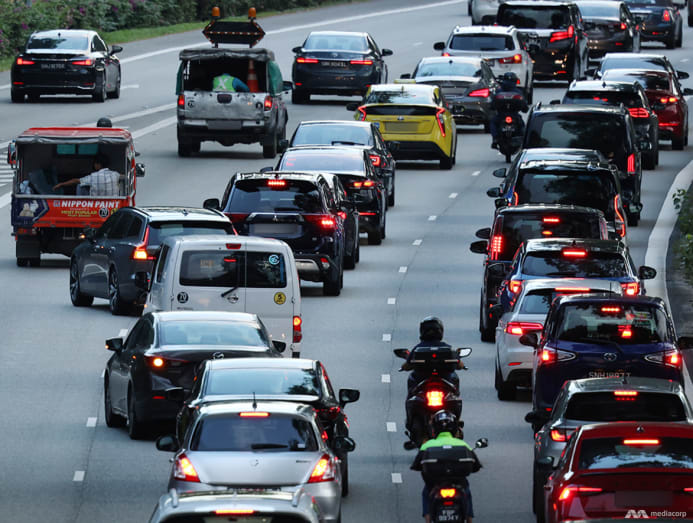
MP for Aljunied Group Representation Constituency Sylvia Lim added that there may be a "permissive attitude towards speed" within our road culture.
She shared that in her experiences overseas, it would be common for motorists to honk at others who exceed the speed limit, whereas norms here include honking at and overtaking a vehicle from the left if it is travelling at the speed limit on the right-most lane of an expressway.
Assoc Prof Faishal said in response to both Mr Tan and Ms Lim that every person has a part to play in improving road safety.
"At the end of the day, we need to internalise this whole element within each of us that there are people around us who also are using the road," he said.
"When you know that these road users have families ... I think more care will be applied in the way we use our devices on the road."
He also emphasised that while the Government will do all it can to keep Singapore’s roads safe, "road safety is necessarily a shared responsibility".
While some motorists agree that road safety is a shared responsibility, they still believe that heavier punishments need to be meted out as those who subscribe to the above philosophy tend not to be the people causing accidents in the first place.
Mr Khoo, the digital marketing manager, said: "While an individual may be a decent driver, if the driver or motorcyclist around him or her isn’t as vigilant, then the accident still becomes inevitable.
"Until the Government takes more steps to enforce and remind (motorists), I honestly think the situation won’t improve and the cycle (of increasing accidents) will just keep repeating."
The article was originally published in TODAY.





.JPG?itok=7fxHA5k7)






